
Lumber is wood that has been processed into uniform and useful sizes, including beams and planks or boards. Lumber is mainly used for construction framing, as well as finishing. Lumber has many uses beyond home building. Lumber is sometimes referred to as timber in England, Australia, and New Zealand, while in most parts of the world the term timber refers specifically to unprocessed wood fiber, such as cut logs or standing trees that have yet to be cut.
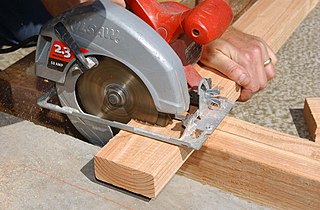
A circular saw is a power-saw using a toothed or abrasive disc or blade to cut different materials using a rotary motion spinning around an arbor. A hole saw and ring saw also use a rotary motion but are different from a circular saw. Circular saws may also be loosely used for the blade itself. Circular saws were invented in the late 18th century and were in common use in sawmills in the United States by the middle of the 19th century.

Joinery is a part of woodworking that involves joining pieces of wood, engineered lumber, or synthetic substitutes, to produce more complex items. Some woodworking joints employ mechanical fasteners, bindings, or adhesives, while others use only wood elements.

In woodworking, hewing is the process of converting a log from its rounded natural form into lumber (timber) with more or less flat surfaces using primarily an axe. It is an ancient method, and before the advent of the industrial-era type of sawmills, it was a standard way of squaring up wooden beams for timber framing. Today it is still used occasionally for that purpose by anyone who has logs, needs beams, and cannot or would prefer not to pay for finished lumber. Thus, homesteaders on frugal budgets, for example, may hew their own lumber rather than buy it.

In woodworking, a rip-cut is a type of cut that severs or divides a piece of wood parallel to the grain. The other typical type of cut is a cross-cut, a cut perpendicular to the grain. Unlike cross-cutting, which shears the wood fibers, a rip saw works more like a series of chisels, lifting off small splinters of wood. The nature of the wood grain requires the shape of the saw teeth to be different thus the need for both rip saws and crosscut saws; however some circular saw blades are combination blades and can make both types of cuts. A rip cut is the fundamental type of cut made at a sawmill.

A splitting maul also known as a block buster, block splitter, chop and maul, sledge axe, go-devil or hamaxe is a heavy, long-handled axe used for splitting a piece of wood along its grain. One side of its head is like a sledgehammer, and the other side is like an axe.
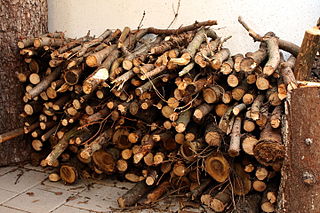
Firewood is any wooden material that is gathered and used for fuel. Generally, firewood is not heavily processed and is in some sort of recognizable log or branch form, compared to other forms of wood fuel like pellets. Firewood can be seasoned and heat treated (dry) or unseasoned (fresh/wet). It is generally classified as either hardwood or softwood.

A froe, shake axe or paling knife is a tool for cleaving wood by splitting it along the grain. It is an L-shaped tool, used by hammering one edge of its blade into the end of a piece of wood in the direction of the grain, then twisting the blade in the wood by rotating the haft (handle).
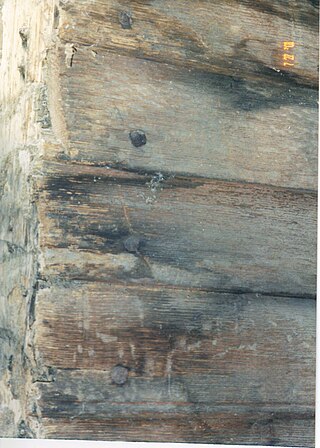
Clapboard, also called bevel siding, lap siding, and weatherboard, with regional variation in the definition of those terms, is wooden siding of a building in the form of horizontal boards, often overlapping.
A wedge is a triangular shaped tool, a portable inclined plane, and one of the six simple machines. It can be used to separate two objects or portions of an object, lift up an object, or hold an object in place. It functions by converting a force applied to its blunt end into forces perpendicular (normal) to its inclined surfaces. The mechanical advantage of a wedge is given by the ratio of the length of its slope to its width. Although a short wedge with a wide angle may do a job faster, it requires more force than a long wedge with a narrow angle.

A bucksaw is a hand-powered frame saw similar to bow saw and generally used with a sawbuck to cut logs or firewood to length (bucking). Modern bucksaws usually have a metal frame and a removable blade with coarse teeth held in tension by the frame. Lightweight portable or foldable models used for camping or back-packing are also available. It is often referred to as a bow saw in the North American hardware market, but that term traditionally refers to a different type of saw with a wooden frame.

Wood shingles are thin, tapered pieces of wood primarily used to cover roofs and walls of buildings to protect them from the weather. Historically shingles, also known as shakes, were split from straight grained, knot free bolts of wood. Today shingles are mostly made by being cut which distinguishes them from shakes, which are made by being split out of a bolt.

Wood grain is the longitudinal arrangement of wood fibers or the pattern resulting from such an arrangement. It has various derived terms refer to different aspects of the fibers or patterns. Wood grain is important in woodworking and it impacts aesthetics.

Bucking is the process of cutting a felled and delimbed tree into logs. Significant value can be lost by sub-optimal bucking because logs destined for plywood, lumber, and pulp each have their own value and specifications for length, diameter, and defects. Cutting from the top down is overbucking and from the bottom up is underbucking.
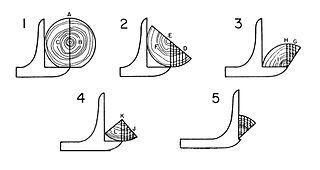
Quarter sawing or quartersawing is a woodworking process that produces quarter-sawn or quarter-cut boards in the rip cutting of logs into lumber. The resulting lumber can also be called radially-sawn or simply quartered. There is widespread confusion between the terms rift sawn and quarter sawn with the terms defined both with opposite meanings and as synonyms.
This glossary of woodworking lists a number of specialized terms and concepts used in woodworking, carpentry, and related disciplines.

An axe is an implement that has been used for millennia to shape, split, and cut wood, to harvest timber, as a weapon, and as a ceremonial or heraldic symbol. The axe has many forms and specialised uses but generally consists of an axe head with a handle, also called a haft or a helve.
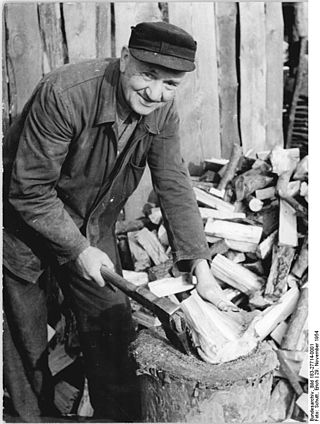
A cleaving axe or cleaver is a form of axe used within green woodworking to split wood lengthways. Cleaving (riving) is used to turn a log into lumber or billets into firewood. Splitting axe is sometimes described as an old name for a splitting maul or froe.
Rift sawing is a woodworking process that aims to produce lumber that is less vulnerable to distortion than flat-sawn lumber. Rift-sawing may be done strictly along a log's radials—perpendicular to the annular growth ring orientation or wood grain—or as part of the quarter sawing process.

















